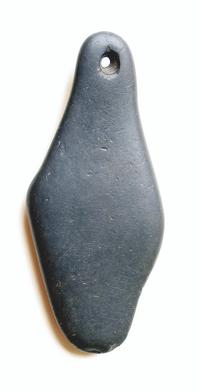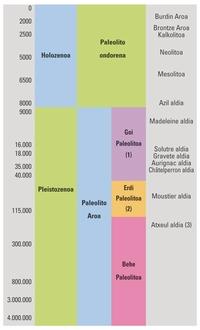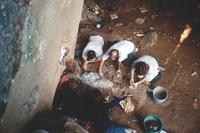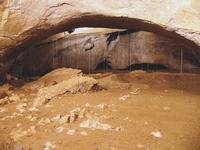Treasure of 15,500 years ago in Praile Aitz
2005/11/01 Imaz Amiano, Eneko - Elhuyar Zientziaren Komunikazioa | Kortabarria Olabarria, Beñardo - Elhuyar Zientzia Iturria: Elhuyar aldizkaria

The word sanctuary comes perfectly to the site of the cave of Praile Aitz I, which archaeologists of Aranzadi believe was used for rites. In the words of Xabier Peñalver, head of research, "Ekain, Altamira, etc. were the place of residence of the people, but in the footsteps, it can be said that they used it to do rites. That's why it's important because it's different." And it is different both at the level of Euskal Herria and at the European level.
They have found a Venus and the pendants of five necklaces, 29 pieces in total, placed in symmetrical spaces on intentionally cobbled terrain and protected by a stalagmitic layer. More than 100 m 2 have been excavated in two cells.
One of the necklaces is made with goat teeth, with three teeth. The three have two holes to hang with two laces or, one of them, painted with ochres, have found it in the passage between two rooms.
The rest of the four necklaces were located in the interior room and are built with stone pendants. The type of rock used is very common in the environment, for example in the river Deba. Just choose smooth stones properly. They are black or dark stones, many decorated with engravings. All have a hole to form the collar.
They are pleasant stones, both in sight and touch. Peñalver also announced it at a press conference to present the discovery: "We have confirmed it, they have a very nice color and a nice shine if we wet it with sweat or water."

One of the stone necklaces has 14 specimens and an approximate length of 1.5 meters. All specimens have appeared on the ground at symmetrical distances. The rest of the necklaces have 6, 3 and 2 specimens.
Finally, a rock has been found in the form of venus, 12 cm long, which also has a hole to be used as a necklace.
In addition to necklaces and venus, archaeologists have found forge, saddle, coal, flint openings and excavated goat bones, as well as a polished fire seat.
Praile Aitz I
Researchers from Aranzadi began in 2000 to study Praile Aitz I, who is in a quarry where he is working. According to the initial excavations, the cave seemed to be the residence of a group of Cro-Magnon. In fact, at the entrance of the cave were found a stove, a stone saddle and goat remains prepared to eat or eat, in addition to the caves used as a place of residence.
Therefore, the researchers concluded that their living beings were hunters and that they hunted goats. Of course, once captured, they ate and accumulated the remains at the front of the cave. It is also known that they went down to the river and headed to the sea due to the remains of the skeletons of the fish. In any case, the presence of industrial waste is practically zero.

The following discoveries have obviously changed those first convictions and now, rather than as a place of residence, they consider it a place of encounter and rites. But we cannot say what kind of rites they did. In other sites of the same time bones have appeared that have been associated with burial rites, but in the cave of Praile Aitz I there is no rest.
According to Peñalver, the discovery is very rare and singular and, moreover, "it is not scientifically proven, but I am almost convinced that all are pieces made by one person, because of their location and decorative motifs show a similar sequence".

The researchers do not know the role of the necklaces; for the beginning, to emphasize the hierarchy, the simple ornament. They lacked at least a tooling function; they can be considered works of art or pieces with social or spiritual functions. "It may be a space associated with a person with special activities or abilities among neighbors."
However, as for the later use of the cave of Praile Aitz I, the traces remain scarce but singular. Thus, at the end of the Magdalenian and at the levels of the Epipaleolithic, command poles have been found, more than 200 marine snails that were not eaten, campfire without remains of fauna, perhaps of ritual use, and many other remains.

Living environment
Praile is located between Deba and Mendaro, in a slope area very difficult to access. In this area have been found numerous caves with remains of the Upper Palaeolithic. On the same slope there was another cave called Praile Aitz II that disappeared as a result of the works of a quarry. If the trees did not avoid it, from Praile Aitze you would see the caves of Ermittia, Iruroin and Langatxo.
Barandiarán and Aranzadi analyzed the cave of Ermittia between 1924 and 1926 and recovered a very important material. Iruroin and Langatxo were excavated in the 1990s, such as Praile Aitz II. This type of congestion indicates that Bajo Deba was highly appreciated by Upper Palaeolithic humans.

It should be noted that the Madeleine period coincided with that of the last glaciation, and that at that time it did not even remove the snow in places above 1.000-1.500 meters. Therefore, Cro-Magnon sought valleys that offered protection, at low altitude and near the sea.
In Peñalver's words, "being a set of these types of deposits is the real treasure, because it helps us to have a certain global vision." And the intention of the researchers goes beyond finding surprising tools and materials, especially they want to know how it was and how those who lived thousands of years ago lived.
At present, the field works of the Praile Aitz I cave are paralyzed, but the samples and information collected are being analyzed to elaborate the final memory.




